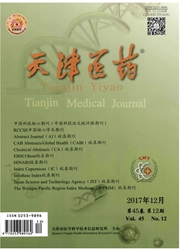

 中文摘要:
中文摘要:
目的观察核素标记叶酸靶向白蛋白纳米微球(^188Re—folate—CDDP/HASMNP)对SKOV,人卯巢癌细胞生长作用的影响。方法建立人卵巢癌细胞SKOV,裸鼠模型,并将64只荷瘤鼠随机分成8组,每组8只,分别为(A)阴性对照组;(B)采用CDDP方案化疗的单纯化疗组;(c)核素靶向内照射的单纯放疗组;(D)磁感应热疗的单纯热疗组;(E)化疗联合放疗组;(F)化疗联合热疗治疗组;(G)放疗联合热疗治疗组;(H)热疗、化疗、放疗联合治疗组。各组经治疗后,观察肿瘤生长增殖情况,计算肿瘤质量抑制率,观察肿瘤组织病理变化。结果各治疗组的肿瘤质量均低于对照组(P〈0.05),且与其他治疗组相比,热疗、化疗、放疗联合治疗组的肿瘤质量最低(P〈0.05)。结论磁感廊热疗、化疗、核素靶向内照射放疗的联合作用能有效抑制卵巢癌的牛长.对卵巢癌治疗具有潜在应用前景。
 英文摘要:
英文摘要:
Objective To investigate the effects of isotope labeled folate targeting albumin nanoparticles (188Re-fo- late-CDDP/HAS MNP) on human SKOV3 ovarian cancer cells in vivo. Methods The human SKOV3 ovarian cancer model was established in mice. Sixty-four tumor-bearing mice were randomly divided into eight groups: (A) negative control group, (B) chemotherapy group, (C) radiotherapy alone group, (D) hyperthermia alone group, (E) chemotherapy combined with radio- therapy group, (F) chemotherapy combined with hyperthermia therapy group, (G) radiotherapy combined with hyperthermia therapy group and (H) hyperthermia, chemotherapy and radiotherapy combined treatment group. After treatment, the cell pro- [iferation and tumor growth were observed. The inhibitory rate of tumor mass was measured. The histopathological changes of tumor were observed in all groups. Results The quality of tumor was significantly lower in treatment groups than that of control group (P 〈 0.05). There was the lowest quality of tumor in hyperthermia, chemotherapy and radiotherapy combined treatment group than that of other treatment groups (P 〈 0.05). Conclusion The combination of magnetic induction hyper- thermia, chemotherapy, targeted radionuclide of radiation exposure can effectively inhibit the growth of ovarian cancer, which has the potential application for ovarian cancer treatment.
 同期刊论文项目
同期刊论文项目
 同项目期刊论文
同项目期刊论文
 The preparation and characterization of folate-conjugated human serum albumin(HSA) magnetic cisplati
The preparation and characterization of folate-conjugated human serum albumin(HSA) magnetic cisplati 期刊信息
期刊信息
